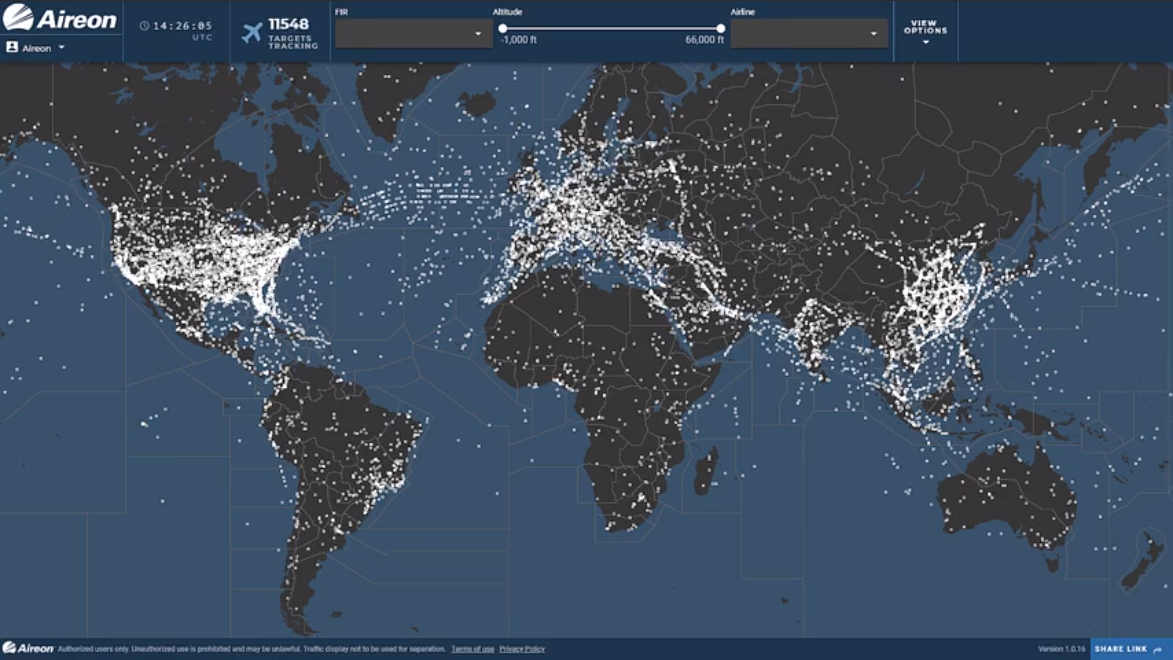
An image of Aireon’s traffic dashboard from last week. (Aireon)
Global air traffic surveillance is now a reality. Aireon’s space-based ADS-B system is up and running and it has launched a trial of its service over the North Atlantic.
“For the first time in history, we can surveil all ADS-B-equipped aircraft anywhere on Earth,” said Don Thoma, Aireon CEO, at an April 2 press briefing at Washington’s International Trade Center.
Aireon’s solution relies on transponders embedded on each of the satellites in Iridium’s NEXT constellation, comprising 66 online with 6 in-orbit spares and 9 grounded spares. Iridium finished building its constellation in January and during February and March, Aireon tested, validated and calibrated the last of its ADS-B payloads.
Leveraging the global coverage of the satellite network, Aireon picks up and stitches together ADS-B Out signals to build a global map. This is especially useful over oceans and certain remote terrestrial locations which previously lacked coverage. That added up to nearly 70% of the world’s surface which was untracked until now, according to Thoma
Because controllers can’t be assured of the precise locations of planes traveling over oceans, they demand separation upward of 80 nautical miles.
“This has ensured that planes are safe, but at the expense of fuel efficiency,” Thoma said.
Aireon clients will be able to get real-time positional updates every 8 seconds rather than the current 14 minutes, which could allow regulators to lower the required separation, increasing the possible traffic on efficient and in-demand oceanic routes, according to Martin Rolfe, CEO of British air navigation service provider (ANSP) NATS, an Aireon Partner.
The separation could safely be reduced to 14 nm between aircraft, which would allow 80 percent of flights to get the routes they want, up from the current 60 percent, he said. On average, airlines could save a net $300 per flight on fuel and produce two fewer tons of carbon dioxide. In addition to working with clients, Thoma said Aireon has worked with ICAO and participating regulators to help facilitate the framework for new oceanic separation standards which would be key to that savings.
The current test is headed up by Aireon partners NATS and Nav Canada, centered on the North Atlantic, which is the world’s busiest oceanic airspace.
“Over 95 percent of the North Atlantic traffic is already ADS-B equipped, so the fuel savings, along with reduced carbon dioxide emissions will be attained very quickly,” said Neil Wilson, president and CEO of Nav Canada.

A graphic of Aireon’s space-based ADS-B system. (Aireon)
The test will impact anybody flying into that airspace. “If you’re equipped with the appropriate transponder, you’re participating,” Wilson said.
Aireon currently has agreements with 11 ANSPs, and is working to get accredited by EASA for organizational safety approval, which would make it the first non-ANSP with that certification. The big hole in its portfolio is the FAA. Despite the busiest and most modern airspace and an ADS-B mandate that goes into effect at the start of next year, the U.S. has not yet contracted Aireon.
“The U.S. has the responsibility for managing a significant amount of airspace. Twenty percent of the world’s oceans are managed by U.S. air traffic controllers,” Thoma said. “If you talk to stakeholders, the U.S. airlines would like to see that fuel savings. They’ve made a significant investment in ADS-B and the ocean represents an opportunity to get some of that benefit early.”
Aireon has been working closely with the FAA since 2011, Thoma said, and plans to start a small trial in the Caribbean later this year, so the company is hopeful that the U.S. will get on board with its service before long.
Thoma wouldn’t confirm other potential customers by name that Aireon is talking to, but said that there was interest both for ATC purposes and to monitor what aircraft are flying into countries’ airspace.
“I won’t comment specifically about China, but let’s just say there are a lot of organizations around the world, and you can make your assessment based on where the air traffic is,” he said.